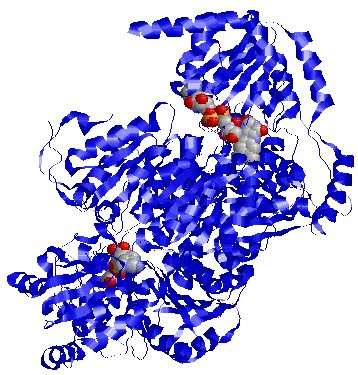 The evolution of new genes and their new enzymes often takes place after a gene duplication event followed by the adaptation of one or both of the duplicated enzymes to a particular substrate.
The evolution of new genes and their new enzymes often takes place after a gene duplication event followed by the adaptation of one or both of the duplicated enzymes to a particular substrate. Most people think of enzymes as being highly specific for a particular substrate so they see this adaptation as an all-or-none affair involving a fairly drastic change in substrate binding. Creationists, in particular, are prone to this mistaken view of biochemistry so they see the evolution of a new enzyme activity as a difficult process. Sometimes they note that several amino acid substitutions are required to change substrates and they declare that this is beyond the reach of gradual evolution.
I'm going to tell you about the evolution of a new enzyme that has been caught in progress. This example will help you realize that enzymes don't have to be highly specific for a single substrate and it will help you appreciate how easy it is to evolve new substrate specificities from sloppy precursors. That's the way it probably happens in most cases.
The top diagram shows the pathways of biosynthesis of three amino acids that have branched side chains: isoleucine, valine, and leucine. Bear with me for a minute while I explain the chemistry—it will be worth it in the end.
In order to make isoleucine you need to combine two simple molecules, pyruvate and α-ketobutyrate, to make a molecule with seven carbon atoms. This molecule then undergoes three reaction to produce the six-carbon molecule α-keto-β-methylvalerate (with the loss of CO2). Now look at the pathway for the synthesis of valine and leucine (on the right). The first step combines a molecule of pyruvate with another molecule of pyruvate to produce a six-carbon compound that is subsequently converted to the five-carbon compound α-ketoisovalerate.
 The neat thing about these two pathways is that the first four steps are catalyzed by the same four enzymes! Each of these enzymes is capable of recognizing two different substrates.
The neat thing about these two pathways is that the first four steps are catalyzed by the same four enzymes! Each of these enzymes is capable of recognizing two different substrates. For example, the first enzyme is acetohydroxy acid synthase. It can combine a pyruvate molecule with another pyruvate molecule or with α-ketobutyrate. Both reactions are catalyzed at high efficiency. The normal enzyme has a preference for α-ketobutyrate as the acceptor molecule because the concentration of α-ketobutyrate inside cells is much lower than the concentration of the donor molecule, pyruvate. This preference ensures that the rate of synthesis of isoleucine is comparable to synthesis of valine and leucine.
There are two similar genes for acetohydroxy acid synthase in some bacteria. They clearly arise from a recent gene duplication event. One of the genes encodes an enzyme with the standard preference for α-ketobutyrate but the other encodes an enzyme that prefers to combine two molecules of pyruvate. Both enzymes (AHAS I and AHAS II) catalyze both reactions but they differ in their preference for the acceptor substrate (Epelbaum et al. 1998, Steinmetz et al. 2010).
 Under normal growth conditions (glucose as a carbon source) in Salmonella typhimurium, the typical enzyme that prefers α-ketobutyrate as acceptor (ASAS II) is all that's required. (You can knock out the other gene and growth isn't affected.) However, the other isozyme (ASAS I) is essential when the cells are grown on acetate as the sole carbon source. This is because in the presence of acetate the internal concentration of pyruvate is low so you need an enzyme that binds both acceptor molecules equally well.
Under normal growth conditions (glucose as a carbon source) in Salmonella typhimurium, the typical enzyme that prefers α-ketobutyrate as acceptor (ASAS II) is all that's required. (You can knock out the other gene and growth isn't affected.) However, the other isozyme (ASAS I) is essential when the cells are grown on acetate as the sole carbon source. This is because in the presence of acetate the internal concentration of pyruvate is low so you need an enzyme that binds both acceptor molecules equally well. What we have here is an example that helps us understand how homologous enzymes may have evolved in the ancient past. The ancestral enzyme was capable of catalyzing several similar reactions. Following a gene duplication event, the two separate genes evolved independently to specialize in just one of the reactions that the original enzyme could catalyze. Neither of them had to evolve an entirely new substrate binding site, they only had to hone an already existing site.
The important observation is that not all enzymes are highly specific. Even modern enzymes that catalyze common reactions can be shown to catalyze similar reactions at a low level. The important conceptual point is that ancient enzymes were certainly very sloppy and frequently catalyzed a wide range of similar reactions. This is what you expect during early evolution. You don't expect highly efficient, highly specific, enzymes to just pop into existence out of the blue.
The take-home lesson is that the evolution of two homologous enzymes that catalyze different, but similar, reactions did not arise by switching from one activity to another. Instead, they arose from a common ancestor that could catalyze both reactions.
[The pathways are from Moran et al. (2012) Principles of Biochemsitry and the enzyme is acetohydroxy acid synthase from yeast (PDB=1T9C)]
Epelbaum, S., LaRossa, R.A., VanDyk, T.K., Elkayam, T., Chipman, D.M., and Barak, Z. (1998) Branched-chain amino acid biosynthesis in Salmonella typhimurium: a quantitative analysis. J. Bacteriol. 180:4056-4067. [PubMed Central]
Steinmetz, A., Vyazmensky, M., Meyer, D., Barak, Z.E., Golbik, R., Chipman, D.M., and Tittmann, K. (2010) Valine 375 and phenylalanine 109 confer affinity and specificity for pyruvate as donor substrate in acetohydroxy acid synthase isozyme II from Escherichia coli. Biochemistry 49:5188-5199. [PubMed]







